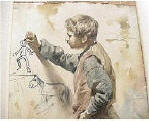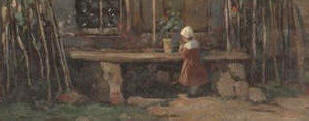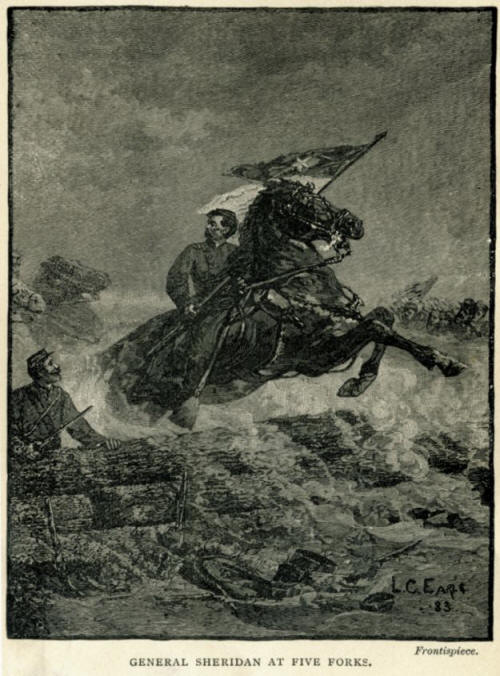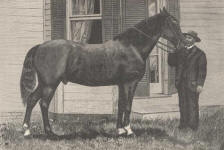LAWRENCE C EARLE
|
||
   |
Home | His Published Life | His Family History | His Art Work
Floral Still Life on
Marble Tabletop 1872
Waiting for the
Fishing Party 1891
(trade card)
Waiting for the
Fishing Party 1891
South Horticultural Bridge
1893
History of Chicago (Murals)
1902
General Sheridan At Five Forks
Title: General Sheridan at Five Forks
Media: Lithograph
Signed: Lower Right
L C Earle '83
Size: unknownImage as published in "Young Folks' History of the Civil War" by Mrs. C. Emma Cheney (Estes and Lauriat, Boston 1884).
The author writes, "Special mention should be also made of the permission, freely accorded her, to make use of Mr. L. C. Earle's faithful and spirited portrait of General Sheridan at the battle of Five Forks, an accurate copy of which the liberality of her publishers has enabled her to present to her readers."
This image was used as the book's frontispiece.
In his book, Father Abraham's Children: Michigan episodes in the civil war, Frank B. Woodford identifies the origins of the horse:
"[Archibald P.] Campbell, born in 1832, entered the service from Port Huron as captain in the 2nd [Michigan Cavalry]. Although a capable officer, Campbell won his fame obliquely by the gift of a horse to Sheridan. The steed, a three-year-old Morgan gelding, was jet black except for three white feet. It stood sixteen hands high. The horse was foaled on a St. Clair County (Michigan) farm and was presented to Campbell by the citizen of Port Huron. Campbell found the steed unmanageable and regarded it as vicious. Sheridan, however, fancied the animal and in August 1862, after some fighting around Rienzi, Mississippi, Campbell gave it to Sheridan, who named it Rienzi. It caused him no trouble. Sheridan described the horse as strongly built, with great powers of endurance, 'and so active that he could cover with ease five miles and hour at his natural walking gait.' "
The following article claimed the horse was foaled at or near Grand Rapids, Michigan. This appears in "Photographic History of the Civil War: Article by Theo. F. Rodenbough, Brigadier-General, United States Army (Retired).
Port Huron is more likely to be the actual truth. Since the regiment rendezvoused in Grand Rapids, it probably was assumed to be Rienzi's place of origin. Campbell's name is not mentioned.
General Sheridan's "Rienzi"
General Sheridan's charger was foaled at or near Grand Rapids, Michigan, of the Black Hawk stock, and was brought into the Federal army by an officer of the Second Michigan Cavalry. He was presented to Sheridan, then colonel of the regiment, by the officers, in the spring of 1862, while the regiment was stationed at Rienzi, Mississippi; the horse was nearly three years old. He was over seventeen hands in height, powerfully built, with a deep chest, strong shoulders, a broad forehead, a clear eye and of great intelligence. In his prime he was one of the strongest horses Sheridan ever knew, very active, and one of the fastest walkers in the Federal army. "Rienzi" always held his head high, and by the quickness of his movements created the impression that he was exceedingly impetuous, but Sheridan was always able to control him by a firm hand and a few words. He was as cool and quiet under fire as any veteran trooper in the Cavalry Corps.
At the battle of Cedar Creek, October 19, 1864, the name of the horse was changed from "Rienzi" to "Winchester," a name derived from the town made famous by Sheridan's ride to save his army in the Shenandoah Valley. Poets, sculptors, and painters have made the charger the subject of their works. Thomas Buchanan Read was inspired to write his immortal poem, "Sheridan's Ride," which thrilled the North.
From an account of this affair in "Scribner's Magazine," by General G. W. Forsyth, who accompanied Sheridan as aide-de-camp, the following is quoted:
The distance from Winchester to Cedar Creek, on the north hank of which the Army of the Shenandoah lay encamped, is a little less than nineteen miles. As we debouched into the fields . . . the general would wave his hat to the men and point to the front, never lessening his speed as he pressed forward. It was enough. One glance at the eager face and familiar black horse and they knew him and, starting to their feet, they swung their caps around their heads and broke into cheers as he passed beyond them; and then gathering up their belongings started after him for the front, shouting to their comrades farther out in the fields, "Sheridan! Sheridan!" waving their hats and pointing after him as he dashed onward .... So rapid had been our gait that nearly all of the escort save the commanding officer and a few of his best mounted men had been distanced, for they were more heavily weighted and ordinary troop horses could not live at such a pace.
In one of the closing scenes of the war -Five Forks- Sheridan was personally directing a movement against the Confederates who were protected by temporary entrenchments about two feet high. The Federal forces, both cavalry and infantry, were suffering from a sharp fire, which caused them to hesitate. "Where is my battle-flag?" cried Sheridan. Seizing it by the staff, he dashed ahead, followed by his command. The gallant steed leaped the low works and landed the federal general fairly amid the astonished Southerners. Close behind him came Merritt's cavalrymen in a resistless charge which swept the Confederates backward in confusion. The horse passed a comfortable old age in his master's stable and died in Chicago, in 1878; the lifelike remains are now in the Museum at Governor's Island, N.Y., as a gift from his owner.
Rienzi died in 1878. Sheridan had his body preserved. Today, in the Smithsonian’s Hall of Armed Forces History, Rienzi stands, saddled as he was that golden October morning:
Here is the steed that saved the day
By carrying Sheridan into the fight,
From Winchester, twenty miles away!
*Thanks to Dr. J. Gray Sweeney for permission
to use material from
Artists of Grand Rapids 1840-1980, J. Gray Sweeney; Grand Rapids, 1981:
The Grand Rapids Art Museum, The Grand Rapids Public Museum
Copyright of content compilation 2006-2020
![]()

